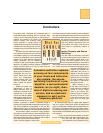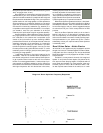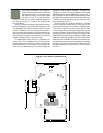
copy-protection problem), DVD-Audio and
SACD players will have six analog outputs for
reproducing multi-channel music discs. Unless
your controller has a discrete six-channel ana-
log input, you won’t be able to play high-reso-
lution multi-channel music through your sys-
tem until the copy-protection dust has settled.
The six-channel analog input approach has its
drawbacks: You’re paying for six DACs in the DVD-
A or SACD player and for six DACs in the controller. It
would obviously be better and more cost effective if multi-
channel DVD-A or SACD was provided to the controller in a
single digital data stream. Until then, the most important
thing to look for is that the analog bypass is available for the
DVD-A and SACD signals. Adding extra layers of conversion
will only degrade the sound. The issue becomes more com-
plicated when you add bass management to the mix, since
bass management is done in the digital domain.
After DSP – Digital to Analog
Conversion
Every 5.1-channel controller has six digital-to-analog con-
verters (DACs) and six analog output stages built into it. The
DACs convert the digital data for each channel into analog
signals. The quality of these DACs and the subsequent ana-
log output stage (which drives the power amplifier through
interconnects) is crucial to realizing good sound quality.
DACs vary greatly in their sound, and a poor-sounding DAC
(or a poor implementation of a good one) can ruin an other-
wise excellent controller. More expensive controllers use
higher quality parts and design techniques, including metal-
film resistors, polystyrene capacitors, four-layer circuit-
boards, and exotic circuit board material. Also look for ana-
log stages made from discrete transistors instead of inex-
pensive operational-amplifier chips. Some High End compa-
nies now have considerable expertise in designing cutting-
edge digital converters, expertise they can apply to building
multi-channel digital controllers.
D o n ’ t be swayed by marketing hype that touts the DACs as
“24-bit.” Although the DAC may have 24 resistor “rungs” on its
“ l a d d e r,” that doesn’t mean it has 24-bit resolution. The last
four bits often contain just noise, not real information.
Because real-world DAC technology is limited to 20-bits, those
last four bits are known in the industry as “marketing bits.”
The best minds working today in digital conversion cite
the historical “two bits per decade” rule of con-
verter advancement. Assuming this rate contin-
ues, consider this: 24-bit digital audio has a the-
oretical noise floor of –144 dBV, but the thermal
noise produced by a single 1,000 ohm resistor
(generated by random movement of electrons)
at room temperature is –125 dBV, a noise floor
19 dB higher than a 24-bit converter’s theoretical
limit. I doubt that converter technology will
advance beyond 21 bits without a fundamental break-
through employing new DAC architectures.
(Inter)Facing the User
Most of this article has been concerned with the path of a sig-
nal from input to output and the wide variety of turns
between. But how the user operates a controller with all
these features is just as important as the raw technology that
makes the magic. A controller can be easy to set up initially
and a joy to use on a daily basis. Or it can be a confusing
nightmare that makes you feel lucky to get any sound at all
from your speakers – never mind fine-tuning the controller
for the best performance. Which of these scenarios comes to
pass is determined by the controller’s user interface, a term
that encompasses the front-panel controls and display, the
remote control, and the on-screen display. Some products are
easy and intuitive to use; others are frustrating and complex.
Before buying a controller, ask the salesman to run through
the system set-up; if he has a hard time, watch out. Second,
play with the unit yourself in the store; you’ll not only get a feel
for how it works, you can ask questions before you take the
controller home. Third, take a close look at the remote; if it is
covered by a sea of identically sized, shaped, and colored but-
tons, it doesn’t bode well for the rest of the user interface. The
buttons should be color coded, grouped by function, and fea-
ture different sizes according to their frequency of use or func-
tion. And it’s all to the better if they light up in the dark.
Do not underestimate the importance of a well-designed
user interface. It could make the difference between loving
and hating the component that is the heart and brain of your
multi-channel system.
For more information about controllers and other home
theater topics, check out Robert Harley’s book Home The-
ater for Everyone. For information, or to order a copy, call
800-848-5099. Website: www.hifibooks.com
O
ne feature lacking on even some
High End controllers is compo-
nent video input and output jacks.
Component video, carried on three sepa-
rate cables, offers vastly improved picture
quality over composite video, and is even
better than S-Video. As more and more
products with composite-video connec-
tions become available (DVD playe r s ,
HDTV set-top boxes, video monitors),
component-video switching becomes an
increasingly important feature. Most con-
trollers with component-video switching,
however, have no on-screen display from
the component-video output.
If you have a single component-video
source (a DVD playe r, for example) and a
video monitor with component-video
input, you can simply run the component-
video cables directly from the DVD play-
er to your video monitor, bypassing the
c o n t r o l l e r’s video-switching function. Th i s
t e chnique requires that you switch inputs
on your video monitor to wa t ch a DV D.
E ven if your controller has component-
video switch i n g, howeve r, none ava i l a b l e
t o d ay offer cross-format conversion (i.e.,
S - Video input to component-video out-
put), meaning you still must switch
inputs on your video monitor when
wa t ching a component-video s o u r c e .
Although component-video switch - ing will
become increasingly common, multiple
RCA jacks ta ke up valuable rear-panel real
e s tate. Some products just don’t have
the room. R H
Component-Video Switching


















